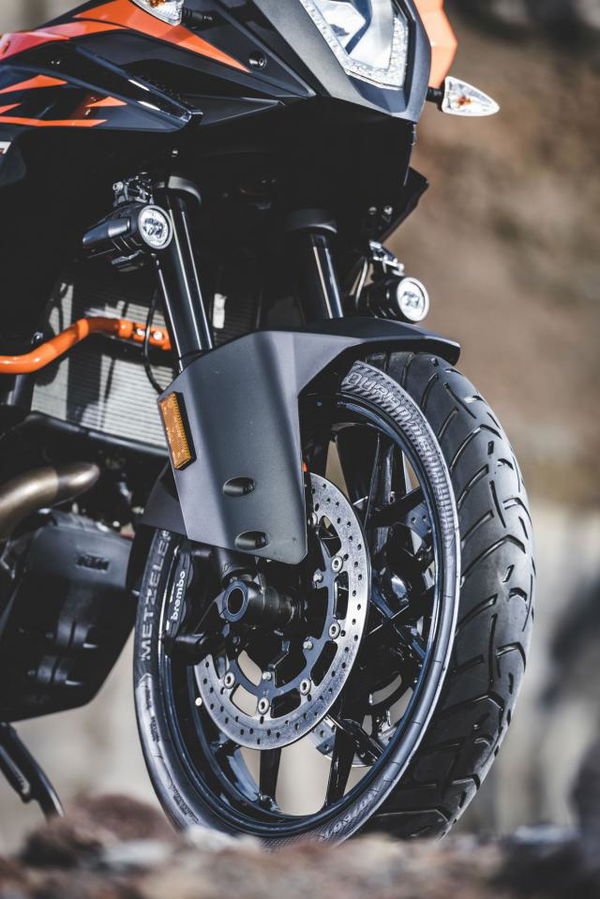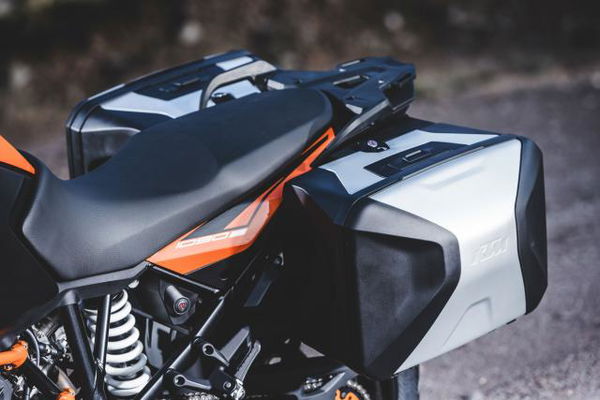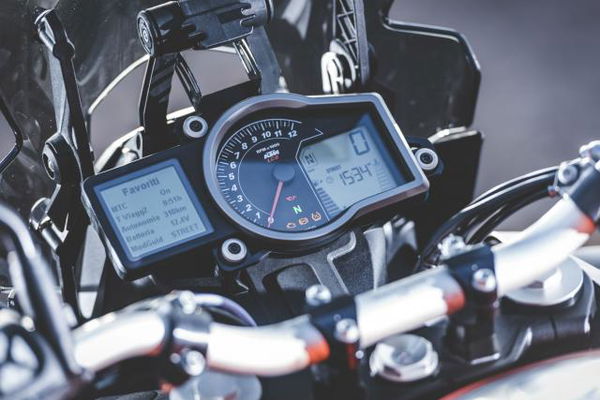First ride: KTM 1090 Adventure review
30hp boost for 2017 means big adventure-bike performance at a near entry-level price

LOWER emissions usually require bikes to go up in capacity just deliver the same power.
Not in the case of the KTM 1090 Adventure, which makes 30hp more than its predecessor, the 1050 Adventure, and remains the same capacity despite the name change.
So it’s 125hp instead of 95hp; still 1050cc; and more efficient, in line with Euro4 limits.
The old one was kept at 95hp so that it could be restricted to 47.5hp for A2 licence holders, under rules which say eligible bikes must not make more than double that to begin with.
Now the firm is offering a separate variant that makes 47.5hp out of the box, and which, we are told, cannot be tampered with to unleash the extra 80hp potential of the V-twin motor.
It’s jumping from a swing to a roundabout to meet the fickle demands of people making motorcycle rules in a vacuum of insight, but for once it means more power, at least for those with an unrestricted licence. Quite a lot more power, actually. The fools!
As with 1290 Super Adventure, KTM has also split the model into more than one variant: a “more off-roading” 1090 Adventure R, with wire-spoked wheels, and a sportier edition called simply the 1090 Adventure and retaining cast aluminium wheels. That’s the one I rode at the launch in Corsica.
Read about the new 1090 Adventure range here.
The name change is presumably to reflect its close relation to the 1290 Super Adventure with which it shares a platform.
The 1090 now makes as much power as BMW’s R1200GS while weighing less. The BMW’s claimed weight includes fuel, at 244kg, while the KTM’s figure is dry, at 205kg. Even with the GS’ 20-litre tank, it seems likely that fuel and fluids will not account for the 39kg difference.
The 1090 is also 10kg lighter than the 1290 Super Adventure S, which KTM launched at the same event, having journalists ride one in the morning and one in the afternoon.
I’d been so impressed with the technology-packed 1290 in the morning that the 1090 was starting from the back of the field in the afternoon, but it took until the first corner for the weight advantage to become evident.
The 1290 handles excellently but the 1090 tips into a lean with less effort, more quickly.

Most of the weight difference will be down to the loss of the highest-spec equipment and rider aids. Gone is the cornering ABS and lean-angle-sensitive traction control, along with the inertial measurement unit that makes them possible.
Gone is the up/down quick-shifter, semi-active suspension, TFT full colour dash and cornering headlight, along with three grand off the price, making the 1090 £11,299.
Retained is dis-engageable ABS and traction control with three riding modes: Sport, Street and Rain. An additional Offroad ABS and traction control mode is available as an option (and KTM says the model still has off-road potential despite being a road-biased variant).
The 1090 also a has a ‘power-assisted slipper clutch’ to inhibit rear wheel lock on downshifts and make the lever easier to pull.
Less electronic jiggery-poker means less intervention between action and consequence, making the 1090 more of a pure riding experience than its bigger sibling. If you’re riding well, it’s because you’re riding well, not because semi-active suspension is making constant damping adjustments to absorb your clumsiness.

I think because of that, and it’s greater cornering agility, I quickly found the 1090 hugely rewarding on Corsica’s twisty roads, and if anything pushed it harder than the 1290.
Peak torque is 80lbft – only 7lbft more than the 1290 makes at 3,000rpm, and 12lbft less than the peak of the R1200GS.
That means you can’t just stay in third gear between corners quite as much as on the 1290, and overtaking a car is more likely to require a downshift. In third, above about 5,000rpm is where the motor really begins to sprint but it’s plenty capable of rapidly eating straights when it does, and working for power can be rewarding too.

An annoying Audi driver was going just fast enough to be a nuisance to overtake on tight and twisty roads, and it was very satisfying to pass by out-braking him with the 1090’s twin four-pot radial-mounted front calipers and then tipping the bike into a bend.
The Metzeller Tourance Next front tyre had no problem with the quick change of demands and the WP fork told me what was going on.
Through the turn, the smooth initial throttle response made it easy to feed in the power and pull away.

The 1090 should be a near equal to the 1290 when you want to stop chucking it around and eat a thousand miles of motorway.
It doesn’t have a ‘Comfort’ suspension mode and the seat is slightly less plush. It’s 10mm lower on paper, at 850mm. In practice I didn’t notice the difference. I’m 5’9” and could get the balls of both feet comfortably on the ground.
The 1090’s easy to manoeuvre at low speed, helped by the wide bars and upright riding position.
The Screen is a different shape to the 1290’s, not as wide at the top and slightly lower. It’s still adjustable but the process requires the unfastening of a catch on either side instead of turning a knob.
Panniers are available as an option.

As with the 1290, the position of the bars, footrests, gear lever and dash are all adjustable.
The dash is much simplified, and includes an old-fashioned analogue tacho, but still involves menus of settings in a digital display, which must be navigated using buttons on the left bar.
Like the 1290, the 1090 Adventure could be fiddly to get into neutral, preferring to go from first to second, and there was sometimes a delay in the green light coming on to tell me I'd managed it.

At £11,299 the 1090 Adventure is roughly £1,000 cheaper than the very cheapest R1200GS.
Perhaps a closer match is the Ducati Multistrada 950, but that has less power and torque from its smaller engine and costs almost as much, at £10,995 in red or £11,195 in white.
The Multistrada 1200 starts from £13,795 and is more closely matched with the 1290 Super Adventure, while the Honda Africa Twin has more of an off-road bias.
KTM says the 1090 Adventure is the ‘entry to the exciting world of KTM Travel Enduros’ but it’s not really an entry-level motorcycle.
It’s a well-equipped, fast, agile adventure-sports bike - a tourer that’s also a thorough blast on back roads – at a near entry-level price.
Model tested: KTM 1090 Adventure
Price: £11,299
Engine: 1050cc liquid-cooled 75° V-twin
Power: 125hp @ 8,500rpm
Torque: 80lbft @ 6,500rpm
Dry weight: approx. 205kg
Clutch: Slipper clutch, hydraulically operated
Traction control: Three-mode dis-engageable (off-road mode optional)
Frame: chromium-molybdenum-steel trellis, powder coated
Sub-frame: aluminium, powder coated
Front suspension: WP USD Ø 43mm
Rear suspension: WP shock, adjustable for pre-load and rebound damping
Suspension travel: 185mm front, 190mm rear
Front brake: twin Brembo four-piston radially mounted calipers, 320mm discs
Rear brake: Brembo two-piston fixed caliper, 267mm disc
ABS: Bosch 9M+ two channel (dis-engageable, Offroad mode opt.)
Wheels: cast aluminium 3 x 19" front; 4.5 x 17" rear
Tyres: 110/80-19 front; 150/70-17 rear
Silencer: stainless steel with regulated catalytic converter
Seat height: 850mm
Fuel capacity: approx. 23 litres (3.5 litres reserve)











